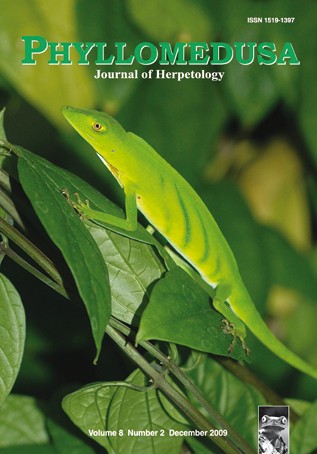Microhabitat use and spatial distribution in Picado's Bromeliad Treefrog, Isthmohyla picadoi (Anura, Hylidae)
DOI:
https://doi.org/10.11606/issn.2316-9079.v8i2p125-134Keywords:
Anura, Hylidae, Isthmohyla picadoi, bromeliad, phytotelmata, upper humid montane forest, Batrachochytrium dendrobatidisAbstract
Isthmohyla picadoi is a Neotropical hylid frog found in upper humid montane forests of Costa Rica and Panama. The species is of particular interest because it continues to persist in an area in which the amphibian community has otherwise been decimated by the pathogenic fungus, Batrachochytrium dendrobatidis. Ground search, ladder climbing, and tree climbing techniques were used to locate 32 individuals; including adult males and females, juveniles, and metamorphosing frogs. The majority of frogs were found in bromeliads, although some individuals were found on plants of the Euphorbiaceae, Musaceae, and Heliconiaceae families. Most frogs were found in larger bromeliads (45 cm or wider). There was a positive correlation between SUL and bromeliad width within the population but not within maturity classes (adult males, adult females, all adults, nonmetamorphosing juveniles), suggesting that juvenile and adult frogs differ in bromeliad usage. Ranges of SUL and body weight in this particular population are much greater than those reported in previous species accounts.Downloads
Downloads
Published
2009-12-01
Issue
Section
Articles
License
All material originally published in Phyllomedusa belongs to Escola Superior de Agricultura Luiz de Queiroz - Universidade de São Paulo. All contents are under a license of Creative Commons BY-NC-ND.How to Cite
Stuckert, A. M. M., Stone, J. P., Asper, J. R., Rinker, M. G., Rutt, C. L., Trimmer, N. C., & Lindquist, E. D. (2009). Microhabitat use and spatial distribution in Picado’s Bromeliad Treefrog, Isthmohyla picadoi (Anura, Hylidae). Phyllomedusa: Journal of Herpetology, 8(2), 125-134. https://doi.org/10.11606/issn.2316-9079.v8i2p125-134



 Impact Factor (JCR): 0.600
Impact Factor (JCR): 0.600 CiteScore: 1.0
CiteScore: 1.0